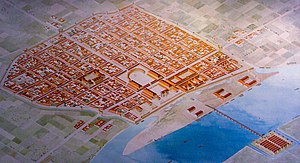Our website is made possible by displaying online advertisements to our visitors.
Please consider supporting us by disabling your ad blocker.
Ripuarian Franks

Ripuarian or Rhineland Franks (Latin: Ripuarii or Ribuarii) were one of the two main groupings of early Frankish people, and specifically it was the name eventually applied to the tribes who settled in the old Roman territory of the Ubii, with its capital at Cologne on the Rhine river in modern Germany. Their western neighbours were the Salii, or "Salian Franks", who were named already in late Roman records, and settled with imperial permission within the Roman Empire in what is today the southern part of the Netherlands, and Belgium, and later expanded their influence into the northern part of France north of the Loire river, creating the Frankish empire of Francia.
Both the Salii and Ripuarii were new names and represented new groupings of older tribal groups on the Roman Rhine border. The ancestors of the Ripuarii originally lived on the right bank of the Rhine, where there had been a long history of friendly and unfriendly contact. Under pressure from their northern enemies, the Saxons, they were first able to infiltrate the left bank of the Rhine in 274 AD. In the chaotic years after the definitive collapse of Roman power in western Europe, they managed to occupy the Roman city of Cologne and the lower and middle Rhineland in present-day North Rhine-Westphalia.
Few historical details are known before the Rhineland kingdom eventually became an important part of the Merovingian Frankish empire in the sub-kingdom known as Austrasia, which also included the original Germanic speaking Salian region. Austrasia included not only the Rhineland-Palatinate, but apparently the whole of the Germania Inferior (re-named in the Late Roman Empire as Germania II) and Gallia Belgica II. The border between Austrasia and Neustria was the Silva Carbonaria in modern Wallonia, but the exact definition of this forest region is now unclear.
On the right bank of the Rhine, the Ripuarian Franks had control over the river basin of the Main, in later years also called Franconia, one of the five stem duchies, from which in the middle of the 9th century the kingdom of Germany was formed.
In the 7th century a law code for Austrasia was published as the Lex Ripuaria. After the reign of the last capable Salian Frankish king, Dagobert I in 639, the Carolingian Austrasian mayordomos gradually took over power, transforming Austrasia into the heartland of the Carolingian Empire.
Previous Page Next Page


